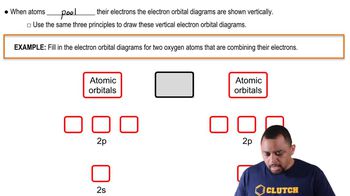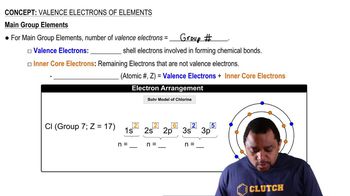The molecule shown here is called furan. It is represented in the typical shorthand way for organic molecules, with hydrogen atoms not shown, and each of the four vertices representing a carbon atom. e. The bond angles in furan are much smaller than those in benzene. The likely reason is which of the following? i. The hybridization of the carbon atoms in furan is different from that in benzene. ii. Furan does not have another resonance structure equivalent to the one shown here. iii. The atoms are forced to adopt smaller angles in a five-membered ring than in a six-membered ring. [Section 9.5]
Ch.9 - Molecular Geometry and Bonding Theories
Chapter 9, Problem 11a3
For each of these contour representations of molecular orbitals, identify (a) the atomic orbitals (s or p) used to construct the MO (iii)

 Verified step by step guidance
Verified step by step guidance1
Observe the contour representations of the molecular orbitals labeled (i), (ii), and (iii).
Identify the shape and orientation of the orbitals in each representation.
For (i), note the combination of two different colored lobes, indicating a bonding molecular orbital formed from p orbitals.
For (ii), observe the four lobes with alternating colors, suggesting an antibonding molecular orbital formed from p orbitals.
For (iii), recognize the single, symmetrical shape around the nuclei, indicating a bonding molecular orbital formed from s orbitals.

Verified video answer for a similar problem:
This video solution was recommended by our tutors as helpful for the problem above.
Video duration:
1mWas this helpful?
Key Concepts
Here are the essential concepts you must grasp in order to answer the question correctly.
Molecular Orbitals (MOs)
Molecular orbitals are formed by the linear combination of atomic orbitals (LCAO) from the constituent atoms in a molecule. They describe regions in a molecule where electrons are likely to be found and can be bonding, antibonding, or non-bonding. Understanding the shape and energy of these orbitals is crucial for predicting molecular behavior and reactivity.
Recommended video:
Guided course

Molecular Orbital Theory
Atomic Orbitals
Atomic orbitals are mathematical functions that describe the wave-like behavior of electrons in atoms. The most common types are s and p orbitals, where s orbitals are spherical and p orbitals are dumbbell-shaped. The combination of these orbitals leads to the formation of molecular orbitals, which are essential for understanding chemical bonding.
Recommended video:
Guided course

Atomic Orbitals Example
Contour Representation
Contour representations visually depict the shape and distribution of molecular orbitals. These diagrams illustrate regions of high electron density and help identify the contributions of atomic orbitals to the molecular orbitals. Analyzing these representations allows for the identification of the specific atomic orbitals involved in the formation of each molecular orbital.
Recommended video:
Guided course

Main Group Elements Valence Electrons
Related Practice
Textbook Question
Textbook Question
The following is part of a molecular orbital energy-level diagram for MOs constructed from 1s atomic orbitals.
(a) What labels do we use for the two MOs shown?
Textbook Question
For each of these contour representations of molecular orbitals, identify (a) the atomic orbitals (s or p) used to construct the MO (i)
Textbook Question
For each of these contour representations of molecular orbitals, identify (b) the type of MO (s or p) (iii)
Textbook Question
For each of these contour representations of molecular orbitals, identify (b) the type of MO (s or p) (i)
Textbook Question
For each of these contour representations of molecular orbitals, identify (c) whether the MO is bonding or antibonding (i)
